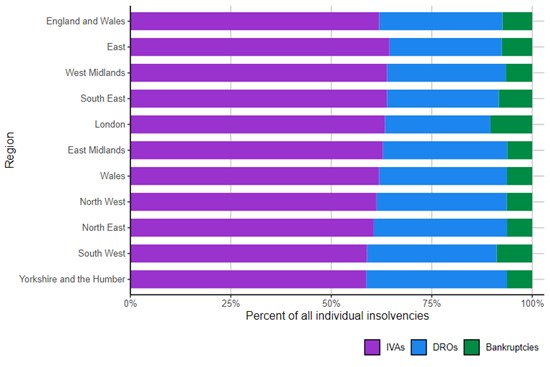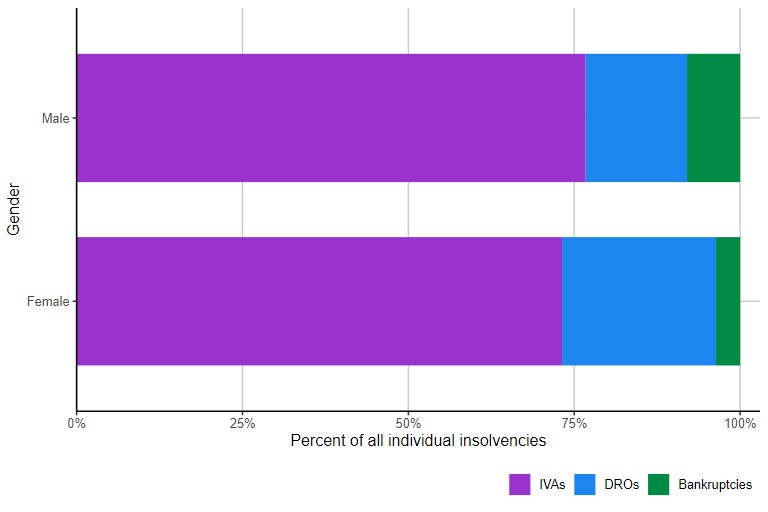
Personal insolvencies ramping up in Stratford Upon Avon?
Personal insolvencies - Stratford Upon Avon
National and Regional Trends
The individual insolvency rate in 2023 was the lowest since 2017. Numbers were driven down due to a lower number of IVA’s compared to the record numbers in 2022.
The North East continued to have the highest rate of insolvency in England and Wales, with the highest number of IVA’s and DRO’s, with the South West having the highest rate of bankruptcy.
London continued to have the lowest rates of insolvency, having the countries’ lowest rates of IVA’s, DRO’s and bankruptcies.
All regions have seen a decline in insolvency rate compared to the five-year average, however, bankruptcy numbers have increased slightly from the historical lows of 2022.
IVA’s continued to account for the majority of personal insolvencies, although they made up a smaller proportion than in 2022.
DRO’s in 2023 was the highest annual number since their introduction in 2009. Historically, bankruptcies were more common than DRO’s in London, but in 2023, more than twice as many people in London had a DRO than a bankruptcy, owing to the expansion of the DRO eligibility criteria in 2021 and the opening of new DRO hubs in 2023.
Source: Insolvency Service
The local authorities with the highest rates were mainly grouped in the North West and North East of England, with 3 out of the top 5 local authorities with the lowest individual insolvency rates being London Boroughs.
The local authority with the highest total individual insolvency rate in 2023 was Halton, with Richmond upon Thames having the lowest individual insolvency rate.
Notably, the local authority with the highest bankruptcy rate in 2023 was Stratford Upon Avon with the lowest being Merthyr Tydfil. Three of the five local authorities with the highest bankruptcy rates were in the South West. This is closely linked to the respective local councils increasing the use of bankruptcy petitions to collect unpaid council tax in their jurisdictions.
Age and Gender
The female insolvency rate was higher than the male rate for the tenth successive year, with women having a higher rate of insolvency for all age groups except those aged 65 and over.
Women are more likely to have a DRO, whilst men are more likely to become bankrupt or enter an IVA.
Insolvency rates were highest for adults aged between 25 and 44, and the lowest for adults aged 65 and over. The long-term trend shows an increase in insolvency for younger adults and a decrease for older adults aged 55 years and older.
An IVA was the most common type of insolvency in all age groups except for those over 65 where DRO’s were more popular.
Source: Insolvency Service
Historically, men had a higher rate of insolvencies than women, but this gender gap narrowed from 2009, and by 2014, women began to have higher insolvency rates than men. This change coincided with a decline in bankruptcy numbers and the introduction and growth of DRO’s. In the same period, women overtook men in terms of IVA proposals.
Breathing Space
The North East and North West were regions with the highest BS registrations in 2023, with London having the lowest. As with other formal insolvency procedures, BS rates were highest for 25 to 44 year-olds and lowest for those over 65.
The road ahead
Whilst the volume of formal personal insolvency procedures remains relatively low, small shifts in the numbers can indicate slightly more dramatic trends than is perhaps the reality. In the coming 12 months we do not anticipate significant increases in the rate of personal insolvencies in England and Wales.
We expect bankruptcy numbers to remain fairly flat, with a slight increase in creditor petitions and lower numbers of debtor’s applications.
IVA numbers will slowly decrease over the coming year, and this will be largely driven by an increase in Breathing Space applications and better signposting of individuals towards a DRO.
From June 2024 the increase in the DRO entry criteria to liabilities of £50,000, as we saw with the abolition of the £90 entry fee, will undoubtedly drive bankruptcy and IVA numbers down and DRO numbers up.
National contact



